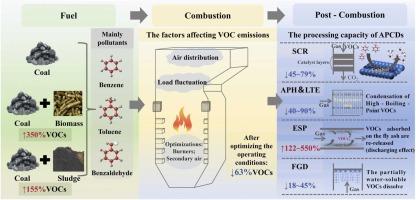超临界燃煤电厂挥发性有机化合物排放特性及燃烧调节与apcd协同控制
IF 11.3
1区 环境科学与生态学
Q1 ENGINEERING, ENVIRONMENTAL
引用次数: 0
摘要
本研究考察了3个超临界燃煤电厂(660 MW、600 MW和330 MW机组)的挥发性有机化合物(VOC)排放特征,包括负荷影响、过剩空气比、燃烧火焰位置(调节燃烧器)、空气污染控制装置(APCD)运行场景以及与生物质(10%)和污泥(10%)共烧5个任务,均在现场进行。每个任务都包括锅炉和apcd上的两个类似设置,以便进行比较。其中包括1.4兆瓦的中试规模,以提供最具挑战性的任务,这些任务难以在发电厂进行。通过优化锅炉燃烧条件,降低了60 ~ 70%的VOC,其中增加火焰中心高度和调整二次风比对VOC的影响最大。其余(30-40%)VOC从锅炉进入APCD系统,尾气中的中心部分VOC通过SCR系统的催化氧化过程被有效氧化。电除尘器对挥发性有机化合物的去除效果可以忽略不计,高压放电增强了飞灰中挥发性有机化合物的再排放。因此,燃烧条件优化与apcd相结合,可以协同去除大多数电厂90%以上的VOCs。此外,生物质和污泥的混合会增加挥发性有机化合物的产生。这项研究对于实现清洁煤炭发电和显著减少挥发性有机化合物排放至关重要。本文章由计算机程序翻译,如有差异,请以英文原文为准。

VOC Emissions Characteristics and Cooperative Control by Combustion Adjustment and APCDs in Supercritical Coal-Fired Power Plants
This study examined volatile organic compound (VOC) emission characteristics in three supercritical coal-fired power plants (660 MW, 600 MW, and 330 MW units), with five tasks: the effect of load, excess air ratio, combustion flame location (adjust the burners), air pollution control device (APCD) operational scenarios, and co-firing with biomass (10%) and sludge (10%), all of which were carried out in situ. Each task included two similar setups on the boiler and APCDs for comparison. A 1.4 MW pilot scale was included to provide the most challenging tasks, which were difficult to conduct in the power plant. Around 60 to 70% of VOC was reduced by optimizing the boiler combustion conditions, which was most influenced by increasing the flame center height and adjusting the secondary air ratio. The rest (30-40%) of the VOC entered the APCD's system from the boiler, and the central portion of the VOC in the tail gas was effectively oxidized through the catalytic oxidation process in the SCR system. The ESP had negligible removal effects on VOC, and the high-voltage discharge enhanced the re-emission of VOCs from fly ash. Thus, combustion condition optimizations combined with APCDs could synergistically remove over 90% of VOCs in most power plants. In addition, the blending of biomass and sludge will increase the production of VOCs. The study is crucial for achieving clean coal power production and significantly reducing VOC emissions.
求助全文
通过发布文献求助,成功后即可免费获取论文全文。
去求助
来源期刊

Journal of Hazardous Materials
工程技术-工程:环境
CiteScore
25.40
自引率
5.90%
发文量
3059
审稿时长
58 days
期刊介绍:
The Journal of Hazardous Materials serves as a global platform for promoting cutting-edge research in the field of Environmental Science and Engineering. Our publication features a wide range of articles, including full-length research papers, review articles, and perspectives, with the aim of enhancing our understanding of the dangers and risks associated with various materials concerning public health and the environment. It is important to note that the term "environmental contaminants" refers specifically to substances that pose hazardous effects through contamination, while excluding those that do not have such impacts on the environment or human health. Moreover, we emphasize the distinction between wastes and hazardous materials in order to provide further clarity on the scope of the journal. We have a keen interest in exploring specific compounds and microbial agents that have adverse effects on the environment.
 求助内容:
求助内容: 应助结果提醒方式:
应助结果提醒方式:


